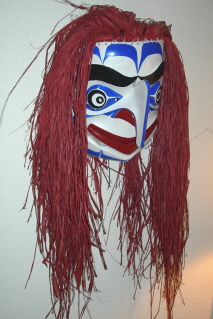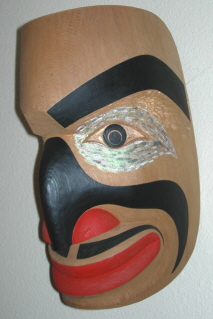Native American Clowns
By Bruce Johnson
Native American tribes (also known as First Nations) are actually many different cultures. So, there are different types of Native American clowns.
The Cheyenne tribe has Contrary clowns. They would walk about the camp on their hands, ride horses backwards, shoot arrows back over their shoulder, and do many other things wrong. When they came to a stream, they would take off one moccasin, and then hold up the bare leg as they hopped through the water. In time of battle, they would revert to doing things the normal way. The other tribes feared the Contraries the most, because they were the most skilled warriors. Contrary clowns are shown in the movie Little Big Man.
The Hopi tribe has several different clown characters. Their appearance is the easiest to find because they are depicted in Kachina dolls. They all paint their bodies. The Koshari or Hano clowns paint their body and face in black and white horizontal stripes. Their costume is a loincloth and a striped hat with two tall thin horns. The Koyemsi (mudhead) clowns wear a spherical felt mask with gourds attached to make it lumpy. Then they paint their bodies and the mask with red clay. The junction between the mask and their body is hidden by a bandana, called a ruff, tied around their neck. They frequently wear a skirt, although they sometimes wear a loincloth and other times pants & shirt. Pictures of these characters can be found in books about Kachinas. Barton Wright wrote two of the best. They are Hopi Kachinas - The Complete Guide to Collecting Kachina Dolls, and Clowns of the Hopi - Tradition Keepers and Delight Makers.
I believe that most of the Native American clowns were masked. I've seen masks of other tribes at the Royal British Columbia Museum, in Victoria, Canada, and at the Native American Museum, in New York City, USA. I don't remember the name of the character or the tribe, but one of the Mexican tribes has an old man clown character. They use goat hair to create a beard and gray hair for the mask. That mask is one of the ones in the museum in New York.
Here are a couple of things I've found interesting about the Native American clowns. Many of the tribes believe their clowns have the power to cure certain diseases. Western medicine is just discovering that humor and laughter does cause beneficial physiological changes.
In many tribes, the clowns have a teaching function. Some tribes believe that laughter opens you up to what the spirits want you to learn. So, before some of the ceremonies could begin, the clowns had to get everyone laughing. A visitor from another tribe might try to prevent the ceremony from taking place by refusing to laugh. Quite often, the clowns are in charge of teaching the ceremonies to the children. The clowns also were in charge of policing the tribe. If somebody were involved in inappropriate behavior, for example getting drunk, the clowns would perform a skit satirizing that person's behavior. The public ridicule was often enough to end the behavior.
The Native American clowns often played an important role in the religious life of the tribe. When some of the tribes converted to Christianity, they created ceremonies portraying events from the Bible. In at least one tribe, the clowns play the people who demanded that Christ be crucified. Underneath their mask, these clowns keep a cross clinched between their teeth as a symbol of their true dedication to Christ while pretending the opposite.
To understand the clown characters of Northwest First Nations, you have to understand their culture because the clowns play an important role within their society.
This explanation is based on conversations with master carver George David, a visit to the Umista Cultural Center in Alert Bay, BC, and trips to other museums and art galleries. George is a member of the Nuu-Chah-Nulth tribe. Any misinformation is the result of my own misunderstanding.
Northwest tribes consider their history to be vital. It is the basis for their status and honor. However, they had no written language to use to record it. Their history was preserved through three mediums: art, dance, and oral tradition.
There are some dances, like the Welcoming Dance, that are owned by everyone. Anybody can dance them. However, most songs and dances are considered valuable personal property. Nobody would dare perform a dance if they could not prove that they had the right to do it. Dances were often inherited, and a dancer would announce that they could do a particular dance because they are the son of…, who was the son of …, who was the son of … Sometimes the chain of inheritance would go back eight or more generations to the person who had created the dance. Some dances were inherited through the father, and others inherited through the mother. When a woman married into a different clan or tribe, she took along some of her clan's dances as her dowry. Sometimes marriages were arranged to obtain ownership of desirable dances. When a father retires from dancing, he chooses which of his sons will inherit specific dances that he owns.
A very important element of transferring rights was an event called the Potlatch. Nothing was legal until it had been announced during a Potlatch. The collected group served as the notary public. Everyone there pledged that they would remember all that they heard. Granting of names, initiation into adulthood, marriages, rights to perform dances, transfer of power, and other business were all announced during the potlatch. The host clan would invite their neighbors to attend as witnesses. After a potlatch, when somebody claimed a right they had been granted, the others might reply, "yes, you own that right because I was there when it was given to you. I remember that you have that right."
If outsiders know anything about a potlatch, it is usually about the elaborate gifts given to the guests at the end of the ceremony. The gifts are payments given to the guests to insure that they will remember what transpired. When a guest touches a gift to accept it, they are giving their approval to everything that was announced and pledging to remember it. The guest then becomes a paid witness.
The potlatch is also a teaching event. The history of the host clan is explained through dance and song. Important lessons are also taught through the dances. For example, in one dance Bak’ was, the Wild Man, tries to capture children wandering alone in the forest. If he can catch them, he will take them away. This dance teaches the children not to go into the forest unaccompanied. That is an important lesson for a tribe living in the wilderness.
Since what happens at a potlatch is so important, it is vital that everyone pays attention and discipline is maintained. In some tribes, the Nulth-Ma clown served as the sergeant of arms. A potlatch would be held in a building called a Long House. The guests would sit around the sides of the room, and there would be a fire in the center. If a child got the giggles or misbehaved in another way, the clown might single them out and make them sit all alone by the fire where everyone could see their shame. The Nulth-Ma could ask people who were behaving inappropriately to leave. The Nulth-Ma also carried a two-foot-long paddle to use in disciplining unruly guests. Sometimes a host would secretly bribe a guest to misbehave so the clown would beat them as a warning to others about what could happen to them.
A modern potlatch may last 24 hours, but in past times a potlatch could last for many days. It would be hard to concentrate about two or three in the morning. Then the host would send in the clowns. The clowns would shift from maintaining discipline to being entertainers. They would get the people to laugh to reenergize them. They would let the people relax their concentration. Then refreshed, the guests were ready to continue with the important business at hand.
The Nulth-Ma Clown of the Nuu-Chah-Nulth Nation wears a mask carved from cedar wood. The mask might have false hair made from cedar bark. A distinguishing characteristic of this clown is the large nose. The character’s name loosely translates into English as "Big Nose." This clown often has a wide grin. His features are painted in red, black, and white, or are left the natural color of the cedar. Some clowns would communicate using a whistle held in their mouth behind the mask.


Nulth-Ma Clown Masks (The one on the right was carved by George David.)
The routines the clowns performed would vary. George David told me his brother would fill the big nose of his mask with raw clams. Then he would pick his nose and offer what he found to others. Something else they might do is using a blanket to create a two-person horse.
The Nulth-Ma clown was not the only clown character of the Northwest Tribes. The name of the character varies by tribe. The Kwakwaka 'wabuc tribe of Vancouver Island calls him Noohlmahl. It is also known as Nutamat.
The Royal British Museum, in Victoria, BC, and the Umista Cultural Center, in Alert Bay, BC, both have masks described as "laughers." These are pure clown characters. Their function is to make people laugh. At the Umista Cultural Center, I was told, "our people believe that laughter is a gift from the spirits. Failure to use a gift is a sign of ingratitude and the ability to use that gift may be taken away. Therefore, it is important to us to include laughter in our ceremonies."
The Potlatch is the most important event in the tribe’s cultures, but clowns or humor might be a part of other ceremonies and events. George David told me of a time when a mask was carved without a nose. In its place was a hole. Each man participating in the event carved a nose that would fit into the mask's hole. Each man took a turn donning the mask under the cover of a blanket. They would attach their carved nose to the mask. Then they would cast aside the blanket to see how hard they could get their companions to laugh.
The Burke Museum at the University of Washington has a mask with interchangeable lips. It is similar to the mask George David described. I don’t know if it was used for comedy.
The Anglo Saxon society tends to equate material possessions with wealth. The Northwest tribes considered honor and respect to be far more valuable. One way to obtain honor was by giving physical gifts to others. The more you were able to give, the more honor you had. Of course, others wanted to obtain honor as well, so they would try to give you back just as much if not more. Another way to obtain honor was by giving of yourself to others. Acts of service earned you respect. George David told me that Caring Clowns who work to relieve the pain of hospital patients would be highly respected by his people and be considered very wealthy.
Clowning in the Northwest goes back several centuries. It predates the first contact between the native tribes and explorers from Europe. Much of it would seem different to us, and some of it would seem similar. One of the chalk talk cartoons that I draw is a body of a frog that turns into the picture of the face of a prince when the paper is turned upside down. In a gallery in Victoria, BC, I saw a carved mask that was the face of a man. When the mask is turned upside down, it becomes the body of a frog.